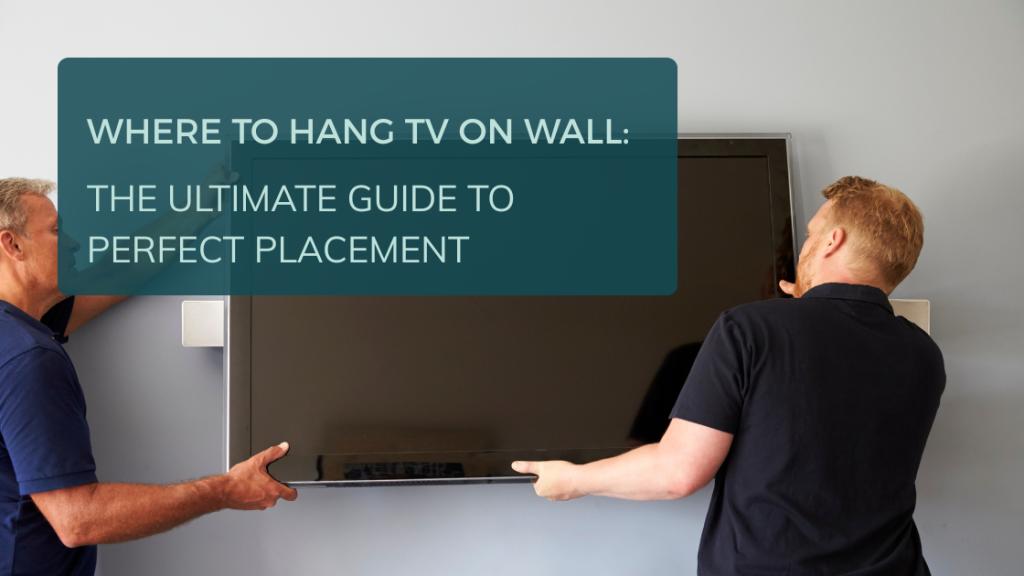So, you’ve bought a new TV – superb! Now comes the major question: where to hang it on the wall so it looks aesthetic and feels comfortable? Believe me, it’s usually more confusing than choosing a show to binge-watch.
Think of this: you sit on your couch with snacks and, by episode four, your neck feels like you’ve tried headstands. Ouch, right? Let’s ensure that doesn’t happen.
Why Choose a Wall-Mounted TV
First of all, why bother mounting it anyway?
Well, it looks so much cleaner, for one. No clunky stand, no gear cramming. Your place instantly looks more modern. Think about the last time you tried vacuuming around that heavy TV cabinet: total hassle.
Plus, if you’ve got curious little kids or a cat that thinks TV stands are jungle gyms,a mountable TV is safer. And depending on the mount type, you’re not stuck; it can tilt, swivel, or pull out so you can watch comfortably from the couch or even the breakfast bar while making coffee.
Picking the Right Wall
Before drilling a single hole, the first step is deciding where to hang TV on wall. Think about where you usually sit. Do you watch straight-on from the couch, or do you curl up on the side with a blanket? If the TV is mounted just off-center, you’ll end up with awkward angles that make watching less enjoyable.
Lighting also matters. Afternoon sunlight can cause glare, and if the TV catches direct light, you’ll struggle to see the picture clearly. In that case, using a tiltable mountable TV helps, as you can angle the screen to reduce reflections. For homeowners who want professional help with placement and installation, a reliable TV mounting service can make sure your setup is both safe and perfectly positioned.
Then there’s the issue of power and cables. You don’t want cords running across the floor, so look for a spot close to power outlets and internet ports. Finally, always check your wall support. A wall-hung TV needs to be mounted into wooden studs. Drywall alone won’t hold it, and you definitely don’t want your TV crashing to the ground. Plan your placement like you’re hanging a heavy, priceless photo because, in TV terms, it basically is.
How High Should You Mount the TV?
The big question is always height: how high should your TV be? One of the easiest tricks is to sit where you normally watch and have someone hold the screen at different heights, or tape out its shape on the wall with painter’s tape. That way, you’ll see exactly how it looks before making any holes.
Most experts agree that the center of the screen should sit about 42 inches from the floor. This is roughly eye level when you’re seated on a couch. Of course, your setup might vary. If you use bar stools or have a loft-style living area, the center might need to be closer to 48 inches. For standing viewing, like in a home gym, the center might be as high as 60 inches.
If you plan to mount the TV above a fireplace, use a tilt mount. Ideally, leave about six inches between the mantel and the bottom of the TV. The tilt will help angle the screen downward, saving your neck from constant strain.
Mount Types: Pick What Works for You
The kind of mount you choose depends on your space and how you use your TV. A fixed mount keeps the TV snug against the wall and works well if you always watch from the same spot. A tilting mount lets you angle the screen up or down, which is perfect if the TV is mounted higher than eye level, like above a fireplace. A full-motion mount gives you the most flexibility. You can pull the TV out, swivel it, and tilt it in almost any direction. This type is especially handy for corner installations or open-plan spaces.
One great example is a friend who had an articulating mount in their kitchen. While cooking, they could pull the TV around to face them, making it feel like the cooking show was happening right in front of them.
Step-by-Step: How to Mount Your TV
Can you wall-mount any TV? Yes, most modern models are designed for it. Here’s the straightforward process. First, use a stud finder to locate studs in the wall. Then figure out exactly where to mount TV on wall. Hold the bracket up to the wall where you want it and mark the holes. Drill small pilot holes into the studs, then secure the bracket firmly. Attach the mounting plate to the TVusually two vertical bars that screw into the VESA holes on the back. With help from a friend, lift the TV and hook it onto the wall mount. Finally, check with a level to make sure it’s perfectly straight before tightening everything. Once that’s done, you’ve learned how to put television on wall like a pro.
Cable Cleanup and Device Placement
Mounting is fun, but then there are the wires. A messy cable situation ruins even the best setup. The easiest fix is to use in-wall cable kits for a seamless, professional look. If you prefer flexibility, paintable cord covers running down the wall can work just as well. You might also add a floating shelf below the TV for your streaming box, console, or soundbar. These little touches take your setup from average to polished.
Common Mistakes to Dodge
There are a few classic mistakes that make TV mounting frustrating later. The most common is mounting too high, which will leave your neck sore. Another is ignoring glare from windows or lights, which can make daytime viewing miserable. Skipping studs is extremely risky, especially for larger TVs, because drywall alone can’t handle the weight. Leaving wires exposed also makes everything look messy. The rule is simple: plan first, drill later.
Pro Finishing Touches
Want your setup to look like it was installed by a professional? Try using painter’s tape to mark out the shape of the TV before drilling. It helps you visualize placement and ensures balance with your furniture. Mounting a soundbar just below the TV adds both style and better audio. Running an extra HDMI or Ethernet cable behind the wall is also smart planning; you’ll thank yourself later when you upgrade your devices. These details make a big difference in presentation and usability.
Room-by-Room Placement Guide
Every room has different needs, so think about how you actually live and watch TV. In the living room, keeping the screen centered at eye level around 42 inches is perfect for family movie nights. In the bedroom, you’ll probably want the TV mounted higher since you’ll be lying down. Ten inches above the living room height usually works well. In the kitchen, it makes sense to mount it up high with a tilt mount so you can see it while cooking. In a dedicated home theater, aim for centered placement and a slight downward tilt to create a cinema-like experience.
These adjustments help you figure out where to place TV on wall depending on the space.
Final Thoughts
That’s your complete, practical guide to TV mounting. From choosing the best wall and finding the right height, to selecting the right mount and cleaning up the wires, the process is all about balancing comfort and design. Once you know how to put television on wall correctly, your space not only looks sleek but also feels cozy every time you press play.
Whether it’s for watching sports, gaming, family movies, or background entertainment while cooking, a properly mounted TV makes a huge difference. With the right planning, you’ll never have to second-guess where to hang TV and you’ll enjoy a setup that looks stylish and works perfectly for your lifestyle.



